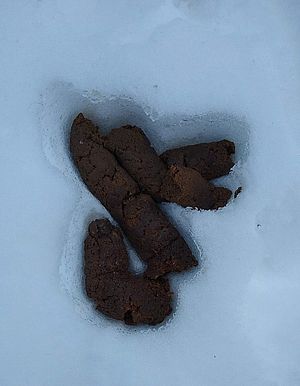Clean Lake Tip – Scoop the Poop, Don’t Bury it in Snow!

Dog poop buried in the snow washes into the watershed with the spring snowmelt, polluting the waters with bacteria, nitrogen, and phosphorus. Photo by Laura Pratt.
During winter, when the snow blankets the ground, dog owners may find it tempting to let sleeping dogs lie – and not clean up after them when they poop! After all, whether you’re walking in town or deep in the woods, what’s the harm in kicking a little snow over the stool and letting nature take its course?
As it turns out, dog droppings are not as innocent as the dogs they come from. They are full of bacteria - the Environmental Protection Agency (EPA) estimates that just 100 dogs over two or three days could contribute enough poop to temporarily close a waterbody. This doesn’t just refer to dog dung on the beach – it’s the residue that washes down the storm drain from streets, sidewalks, lawns and other land surface. Not to mention that dog poop is a terrible fertilizer. In fact, it has the opposite effect – it burns the grass and takes over a year to break down! While you may not see these effects in the winter, the turds don’t disappear in the snow. Winter dog poop is both yucky to step in and becomes a significant pollutant in the spring thaw.
The real harm in leaving the turds lying around, however, is in their two main pollutants: nutrients and pathogens. Nutrients that wash into local water bodies can lead to toxic cyanobacteria blooms, an over-abundance of algae and weeds, and beach closures. Pathogens include disease-carrying bacteria and parasites. Those found in dog poop include salmonella, roundworm, tapeworm, giardia, and E. coli, all of which pose a risk to human health and can linger in the soil for years.
Dog poop differs from wild animal scat, which fertilizes the earth and has been found to spread native seeds. Wild animals are consuming food within the ecosystem where they poop, so there is no net loss or gain of nutrients. Dogs, on the other hand, are fed a high nutrient diet from a bag. Those excess nutrients like nitrogen and phosphorus can throw the ecosystem out of balance when they’re introduced in dog doo, and that instability provides a welcoming environment for invasive species on land and can trigger algae growth and cyanobacteria blooms in the water.
The solution is simple. Pick up after your dog, both at home and on walks regardless of the season, to protect your local water bodies. The EPA recommends that poop be picked up in individual bags and deposited in the trash, to reduce the risk of disease. There are rolls of small bags you can buy for just this purpose, including biodegradable varieties.
If you think this will use up a lot of bags, you’re absolutely right. Dogs poop. Dogs poop a lot. It’s something dog owners know going in, but it can still catch you off guard, especially on a chilly walk. Every responsible dog owner should carry several bags with them at all times.
According to local public works officials, bagging your dog poop and throwing it away is the best way to deal with it. The dog poop will safely break down in the landfill, and its methane gas can be burned for energy recapture. You can purchase compostable doggie bags to avoid using plastic. Don’t flush pet waste down the toilet as too often bags get flushed along with the feces. Even biodegradable bags will damage the wastewater treatment facility’s equipment, and the parasite associated with toxoplasmosis (which is found in cat poop) can survive the water treatment process.
Stay tuned for LCC’s annual <link get-involved events details post april-stools-scoop-the-poop>April Stools Day and Scoop the Poop volunteer events, where you can join your neighbors in picking up the poop in local parks! If you’d like to help LCC organize a clean-up event in your community, please contact LCC ECO AmeriCorps Education & Outreach Coordinator Laura Pratt.
